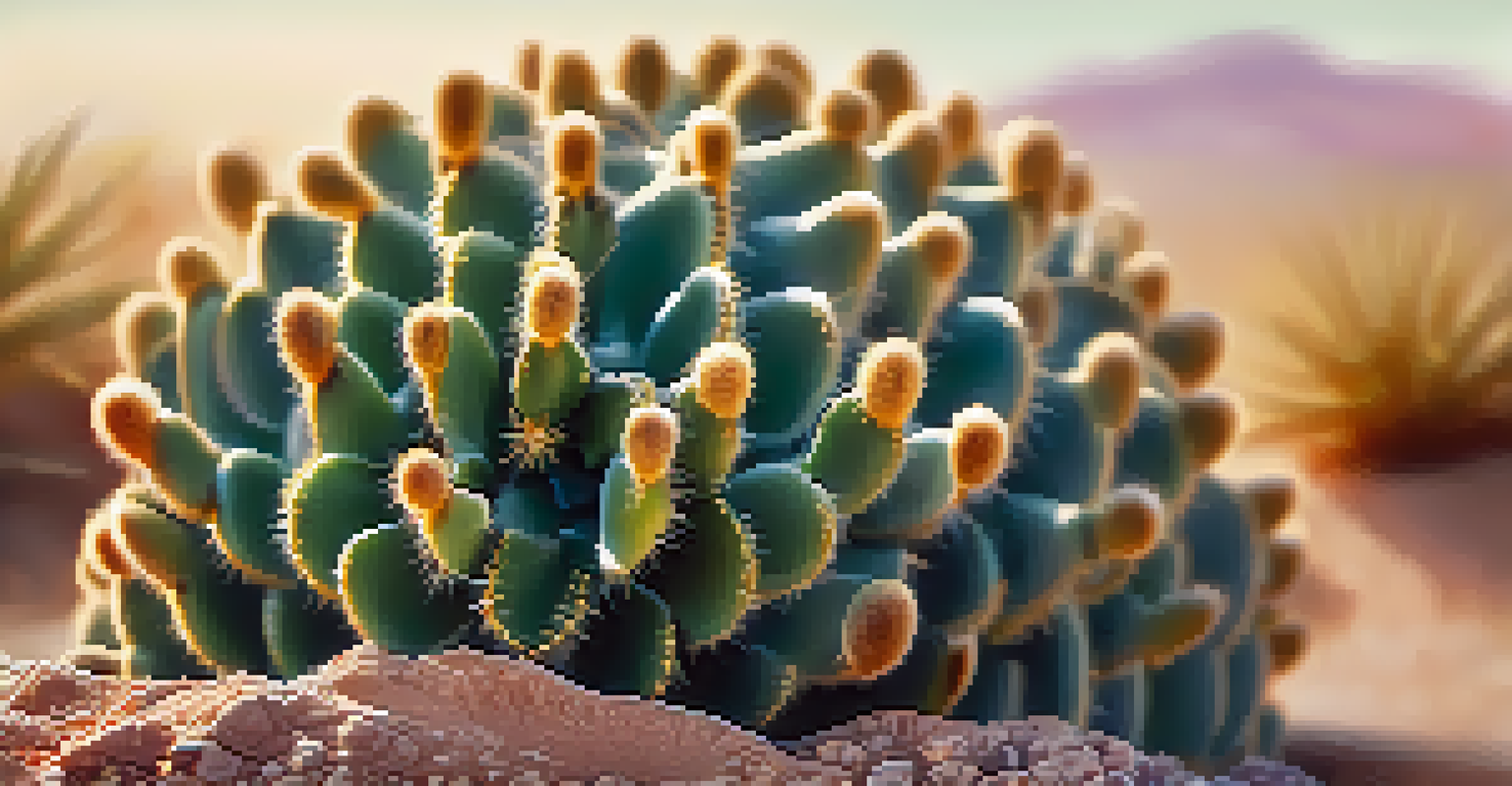The Intersection of Peyote Use and Contemporary Rituals

Understanding Peyote: A Brief Overview
Peyote is a small, spineless cactus known for its psychoactive properties, primarily due to a compound called mescaline. Traditionally, it has been used by Indigenous peoples in North America for thousands of years, primarily for spiritual and medicinal purposes. Its significance extends beyond mere consumption; it represents a deep cultural heritage tied to rituals and communal gatherings.
Peyote is a sacred entity that connects Indigenous peoples to their ancestors and the spiritual world.
In modern contexts, peyote is often associated with the Native American Church, where it plays a pivotal role in religious ceremonies. These ceremonies are not just about the ingestion of the cactus; they are holistic experiences that encompass prayer, music, and community bonding. Through these practices, participants seek personal insights and healing.
The resurgence of interest in peyote among non-Indigenous people highlights a broader trend of exploring alternative spiritual practices. However, this raises important discussions about cultural appropriation and respect for the traditions of Indigenous peoples. Understanding the roots of peyote use is crucial for anyone looking to engage with it meaningfully.
Contemporary Rituals: New Contexts for Old Practices
In recent years, contemporary rituals incorporating peyote have emerged, often drawing inspiration from Indigenous traditions while adapting them to modern lifestyles. These new interpretations can be seen in workshops, retreats, and ceremonies hosted by those who may not have a direct lineage to these practices. While this offers a space for exploration, it also invites scrutiny regarding authenticity and respect.

One common example is the use of peyote in personal growth seminars, where participants seek transformative experiences. In these settings, peyote is often framed as a tool for self-discovery and healing. However, this shift can sometimes overlook the sacred aspects of its traditional use, emphasizing personal gain over communal well-being.
Peyote's Cultural Heritage
Peyote holds deep cultural significance for Indigenous peoples, serving as a sacred entity that fosters spiritual connection and communal healing.
Moreover, the blending of peyote use with contemporary wellness trends, such as mindfulness and holistic health practices, raises questions about the commodification of Indigenous spirituality. It's essential to navigate these waters thoughtfully, ensuring that the core values of respect, reverence, and community remain at the forefront.
Cultural Significance: Peyote in Indigenous Communities
For Indigenous communities, peyote is more than a plant; it is a sacred entity that connects them to their ancestors and the spiritual world. The rituals surrounding peyote consumption are steeped in cultural significance, serving as pathways to healing, guidance, and connection with the divine. Engaging with peyote in these communities often involves a series of protocols and respect for the traditions passed down through generations.
Engaging with a sacred plant requires a deep respect for its cultural significance and the communities that have long used it.
These rituals typically include songs, prayers, and a communal setting that emphasizes unity and shared experience. Participants often describe feelings of profound insight and connection, reinforcing the importance of community in their spiritual practices. In this light, peyote is a facilitator of not just individual experiences, but of collective healing.
The preservation of these practices is vital for cultural identity, especially as external pressures threaten traditional ways of life. Advocating for Indigenous rights and the protection of sacred plants like peyote is crucial in ensuring that these rituals continue to thrive and evolve responsibly.
Legal Landscape: Peyote Use and Regulation
The legal status of peyote varies across different regions, particularly in the United States where it is classified as a Schedule I controlled substance. However, exceptions exist for members of the Native American Church, allowing them to use peyote for religious purposes. This legal distinction highlights the ongoing struggle for Indigenous rights, as access to peyote is often tied to cultural and spiritual identity.
In recent years, there has been a growing movement advocating for the decriminalization and legalization of peyote for therapeutic purposes. Proponents argue that scientific research supports its potential benefits for mental health, addiction, and trauma recovery. This conversation is complex, as it intertwines legal, ethical, and cultural considerations.
Ethical Use of Peyote
Engaging with peyote requires a respectful understanding of its cultural roots and the historical challenges faced by Indigenous communities.
Navigating the legal landscape requires sensitivity to the historical context of peyote use and the voices of Indigenous communities. As more people seek access to peyote for personal and spiritual reasons, it's essential to engage in respectful dialogue and uphold the rights of those who have traditionally held this sacred plant.
Benefits and Risks of Peyote Use in Modern Rituals
Engaging with peyote in contemporary rituals can offer numerous benefits, including personal insights, emotional healing, and a sense of community. Many individuals report transformative experiences that lead to greater self-awareness and a deeper connection to nature and others. These positive outcomes often encourage a deeper exploration of spirituality, promoting holistic well-being.
However, it is crucial to acknowledge the potential risks associated with peyote use, particularly when undertaken without a proper understanding or guidance. Psychoactive substances can lead to intense psychological experiences, and for some individuals, these may be overwhelming or distressing. It's essential for participants to approach peyote with respect and caution, ideally under the guidance of someone experienced in its use.
Additionally, the potential for misuse or appropriation can dilute the spiritual significance of peyote, leading to a disconnect from its roots. Establishing clear intentions and seeking knowledge from Indigenous sources can help mitigate these risks, ensuring that any engagement with peyote remains respectful and meaningful.
Ethical Considerations in Peyote Rituals
As the popularity of peyote in contemporary rituals grows, so too does the importance of ethical considerations. Engaging with a sacred plant requires a deep respect for its cultural significance and the communities that have long used it. This includes acknowledging the historical and ongoing challenges faced by Indigenous peoples regarding their spiritual practices and land rights.
Ethical engagement also involves understanding the dynamics of power and privilege in these rituals. Non-Indigenous participants should approach peyote use as learners rather than appropriators, prioritizing the voices of Indigenous peoples and their teachings. This mindset fosters a more inclusive and respectful environment that honors the traditions surrounding peyote.
Future of Peyote in Wellness
As interest in alternative healing grows, the integration of peyote into modern spiritual practices must balance therapeutic potential with cultural respect.
Ultimately, creating a framework for ethical engagement with peyote can lead to more meaningful experiences for everyone involved. By prioritizing education, respect, and community, contemporary rituals can evolve while still honoring the rich heritage of peyote use.
The Future of Peyote in Modern Spiritual Practices
Looking ahead, the future of peyote in modern spiritual practices is a topic of ongoing exploration and debate. As more individuals seek alternative paths to spirituality and healing, peyote's role may continue to evolve. This evolution is not without its challenges, particularly regarding the preservation of traditional practices and respect for Indigenous wisdom.
Research into the therapeutic benefits of peyote could further influence its integration into contemporary wellness practices. As scientific understanding of psychedelics grows, there may be increased interest in peyote as a potential treatment for various mental health conditions. However, this scientific curiosity must be balanced with a commitment to ethical considerations and cultural respect.

Ultimately, the future of peyote will depend on the collaboration between Indigenous communities and those seeking to engage with its rich spiritual heritage. By fostering respectful dialogue and understanding, it is possible to create a future where peyote continues to be a powerful tool for healing and connection, both in traditional and contemporary contexts.